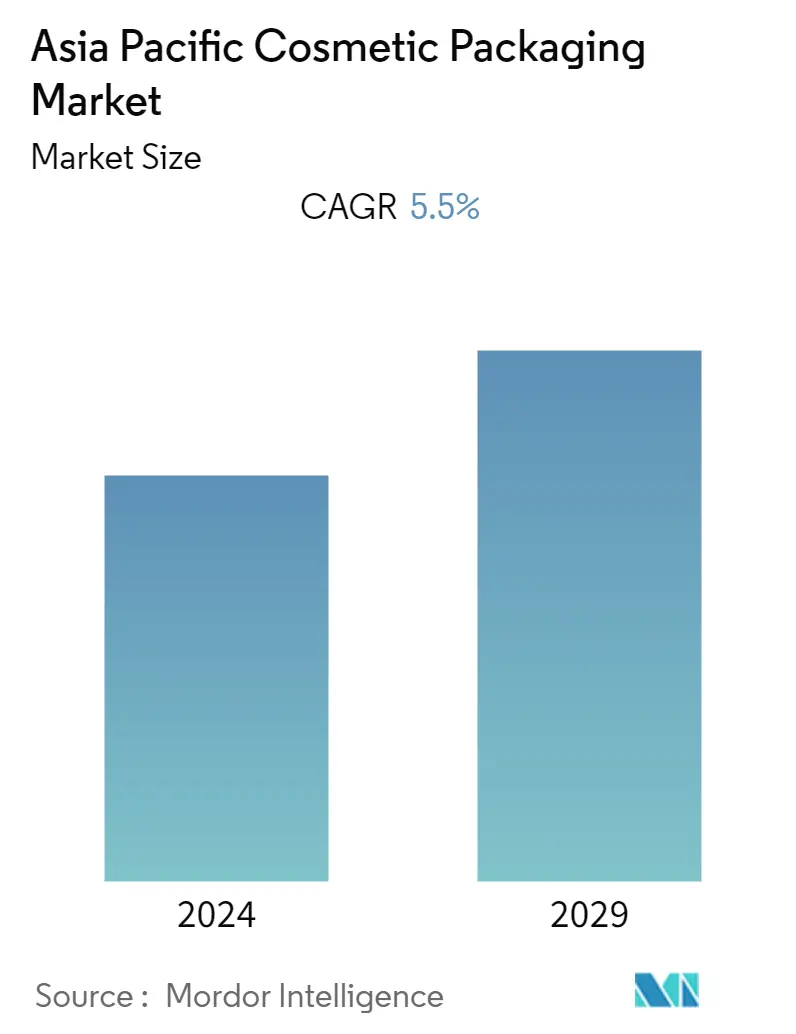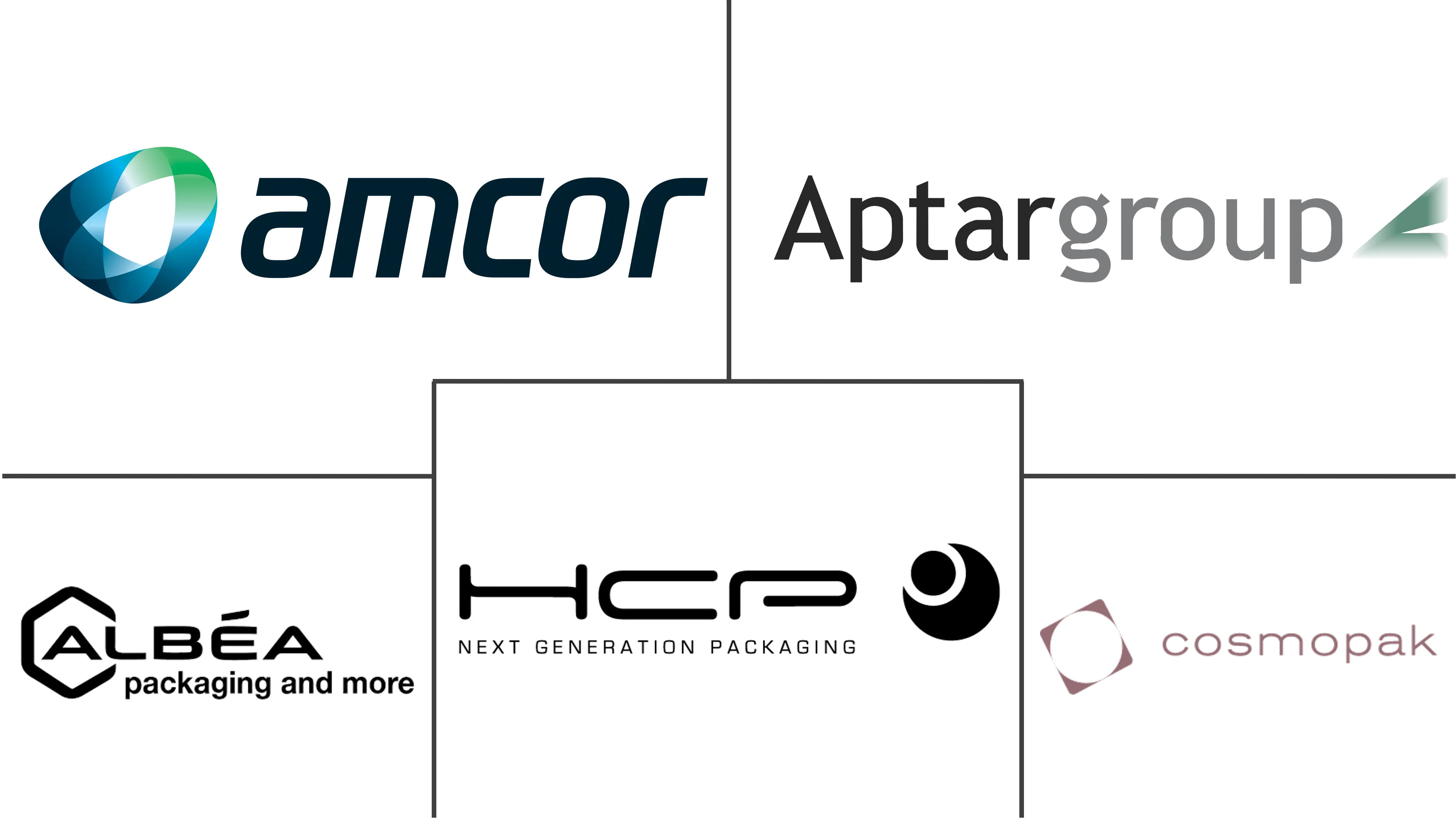Market Size of Asia Pacific Cosmetic Packaging Industry

| Study Period | 2019 - 2029 |
| Base Year For Estimation | 2023 |
| Forecast Data Period | 2024 - 2029 |
| Historical Data Period | 2019 - 2022 |
| CAGR | 5.50 % |
| Market Concentration | Medium |
Major Players
*Disclaimer: Major Players sorted in no particular order |
APAC Cosmetic Packaging Market Analysis
The Asia-Pacific cosmetics packaging market is expected to register a CAGR of 5.5% over the forecast period. The market size reflects the value of packaging used for cosmetics across the countries in Asia-Pacific. The cosmetics industry has the most varied packaging requirements among the other sectors. The materials used also vary, including different metals, paper, glass, and plastics. These materials are used to make containers, pouches, cartons, boxes, tubes, droppers, ampoules, and various types of flexible packaging.
- The region's cosmetic industry is driven by increasing dynamic customer bases in economies such as China, India, Japan, and Indonesia. Factors such as growing beauty consciousness among consumers, affordable cosmetics, and e-retailing are increasing the consumption of cosmetic products in the region.
- Market players also focus on producing innovative and attractive packaging to make their products stand out compared to their competitors. Also, factors such as rising disposable incomes, affordable cosmetic products, the growing popularity of skin care products made with natural and organic ingredients, and surging e-commerce are driving the demand for the cosmetics packaging market in Asia-Pacific.
- The Asia-Pacific region is anticipated to drive packaging volumes in the cosmetics industry, driven by rising disposable incomes and the intense penetration of smaller pack sizes in the form of single-use flexible plastics, which are famous for their immediate affordability. Socio-demographic changes in the region positively impact the demand for natural ingredients for cosmetics and related products. The region's aging populations (in South Korea, China, and Japan) are increasing the demand for natural ingredients with active properties, such as anti-aging.
- Paper-based cosmetics packaging has been seeing high growth in the Asia-Pacific market. Many Asian and global brands are launching their products in paper packaging to meet the growing consumer appetite for sustainable packaging products.
- Paper-based packaging is predominantly used in secondary and tertiary packaging. Most cosmetic formulas contain around 70% to 95% water; therefore, paper is usually not used as primary packaging for cosmetic products. However, many companies are launching cosmetic products that use paper-based, innovative primary packaging solutions. For instance, in November 2021, WOW Skin Science, a personal care brand, launched its bestselling Vitamin C Face Wash in the company's first-ever paper tube packaging. The paper used in the packaging is Forest Stewardship Council certified, and it has a high burst strength and low COBB value, indicating it is strong and stable even in humid conditions.
- The spread of COVID-19 negatively impacted the market due to disruptions in the supply chain due to extended factory closures in the region. It was difficult for bottle, carton, box, and packaging manufacturers to provide these products to cosmetics companies compared to the standard scenario.
However, growing sustainability concerns and increasing consumer awareness regarding the ill effects of plastic on the planet, health, and environment are expected to hinder market growth, although many cosmetic players are still using plastic packaging as plastic is one of the most preferred materials for cosmetics packaging. Also, plastic, in its numerous forms for primary containers, secondary flexible pouches, caps and closures, and nozzles, is one of the primary packaging materials used by the cosmetic market. This is anticipated to fuel growth for the market.
APAC Cosmetic Packaging Industry Segmentation
Asia Pacific Cosmetic Packaging Market is Segmented By Material Type (Plastic, Glass, Metal, Paper), Product Type (Plastic Bottles and Containers, Glass Bottles and Containers, Metal Containers, Folding Cartons, Corrugated Boxes, Tubes and Sticks, Caps and Closures, Pump and Dispenser, Droppers, Ampoules, Flexible Plastic Packaging), Cosmetic Type (Color Cosmetics, Skin Care, Men's Grooming, Deodorants), and Country (China, Japan, South Korea, India, Indonesia, Rest of Asia Pacific).
The market sizes and forecasts are provided in terms of value (in USD million) for all the above segments.
| Material Type | |
| Plastic | |
| Glass | |
| Metal | |
| Paper |
| Product Type | |
| Plastic Bottles and Containers | |
| Glass Bottles and Containers | |
| Metal Containers | |
| Folding Cartons | |
| Corrugated Boxes | |
| Tubes and Sticks | |
| Caps and Closures | |
| Pump and Dispenser | |
| Droppers | |
| Ampoules | |
| Flexible Plastic Packaging |
| Cosmetic Type | |
| Color Cosmetics | |
| Skin Care | |
| Men's Grooming | |
| Deodrants | |
| Other Cosmetic Types (Fragrances, Depilatories, Baby and Child Care, and Sun Care) |
| Country | |
| China | |
| Japan | |
| South Korea | |
| India | |
| Indonesia | |
| Rest of Asia-Pacific |
Asia Pacific Cosmetic Packaging Market Size Summary
The Asia-Pacific cosmetic packaging market is poised for significant growth, driven by the diverse packaging needs of the cosmetics industry across the region. This market encompasses a wide range of materials, including metals, paper, glass, and plastics, used to create various packaging forms such as containers, pouches, cartons, and flexible packaging. The increasing beauty consciousness, affordable cosmetics, and the rise of e-retailing in countries like China, India, Japan, and Indonesia are key factors propelling market expansion. The demand for innovative and attractive packaging solutions is also on the rise, as companies strive to differentiate their products in a competitive landscape. Additionally, the region's growing disposable incomes and the popularity of natural and organic skincare products are further fueling the demand for cosmetic packaging.
The market is experiencing a shift towards sustainable packaging solutions, with paper-based packaging gaining traction due to its eco-friendly appeal. Companies are increasingly exploring paper-based primary packaging options, as seen with brands like WOW Skin Science. However, plastic remains a dominant material due to its versatility and protective qualities, despite growing environmental concerns. The COVID-19 pandemic initially disrupted supply chains, but the market is recovering with a focus on sustainability and innovation. Regulatory changes, particularly in China, are encouraging the adoption of sustainable practices, prompting brands to invest in eco-friendly packaging solutions. The competitive landscape is marked by strategic acquisitions and partnerships, as companies like Carlyle and Watsons collaborate with industry leaders to enhance their sustainability efforts and expand their market presence.
Asia Pacific Cosmetic Packaging Market Size - Table of Contents
-
1. MARKET INSIGHTS
-
1.1 Market Overview
-
1.2 Industry Value Chain Analysis
-
1.3 Industry Attractiveness - Porter's Five Forces Analysis
-
1.3.1 Bargaining Power of Suppliers
-
1.3.2 Bargaining Power of Buyers
-
1.3.3 Threat of New Entrants
-
1.3.4 Threat of Substitute Products
-
1.3.5 Intensity of Competitive Rivalry
-
-
1.4 Assessment of COVID-19 Impact on the Market
-
1.5 Overview of the Global Cosmetic Packaging Market
-
-
2. MARKET SEGMENTATION
-
2.1 Material Type
-
2.1.1 Plastic
-
2.1.2 Glass
-
2.1.3 Metal
-
2.1.4 Paper
-
-
2.2 Product Type
-
2.2.1 Plastic Bottles and Containers
-
2.2.2 Glass Bottles and Containers
-
2.2.3 Metal Containers
-
2.2.4 Folding Cartons
-
2.2.5 Corrugated Boxes
-
2.2.6 Tubes and Sticks
-
2.2.7 Caps and Closures
-
2.2.8 Pump and Dispenser
-
2.2.9 Droppers
-
2.2.10 Ampoules
-
2.2.11 Flexible Plastic Packaging
-
-
2.3 Cosmetic Type
-
2.3.1 Color Cosmetics
-
2.3.2 Skin Care
-
2.3.3 Men's Grooming
-
2.3.4 Deodrants
-
2.3.5 Other Cosmetic Types (Fragrances, Depilatories, Baby and Child Care, and Sun Care)
-
-
2.4 Country
-
2.4.1 China
-
2.4.2 Japan
-
2.4.3 South Korea
-
2.4.4 India
-
2.4.5 Indonesia
-
2.4.6 Rest of Asia-Pacific
-
-
Asia Pacific Cosmetic Packaging Market Size FAQs
What is the current Asia Pacific Cosmetic Packaging Market size?
The Asia Pacific Cosmetic Packaging Market is projected to register a CAGR of 5.5% during the forecast period (2024-2029)
Who are the key players in Asia Pacific Cosmetic Packaging Market?
Amcor PLC, Albéa Group, Cosmopak Corporation, Hcp Packaging Co., Ltd. and AptarGroup Inc. are the major companies operating in the Asia Pacific Cosmetic Packaging Market.

